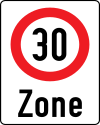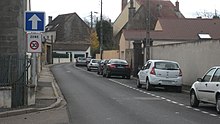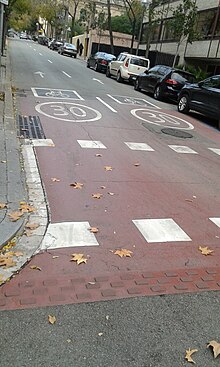30 km/h zone


30 km/h zones (30 kilometres per hour zones) and the similar 20 mph zones (20 miles per hour zones) are forms of speed management used across areas of urban roads in some jurisdictions. The nominal maximum speed limits in these zones are 30 kilometres per hour (19 mph) and 20 miles per hour (32 km/h) respectively. Although these zones do have the nominal speed limit posted, speeds are generally ensured by the use of traffic calming (physical or psychological) measures, though limits with signs and lines only are increasingly used in the UK.[1][2]
Reasons for implementation[]

These zones are generally introduced in areas, particularly residential areas, in an attempt to keep road traffic speeds down to a safe level. The philosophy behind such zones is that the streets in the zone are public space, and they seek to help strike a balance between the realities of an urban area bustling with pedestrian activity and the circulatory function of the roadways. Streets in these zones are considered to be a space for people who live, work, play and study in the area, while people who cross the zone to get somewhere else are excluded. The theory is to reduce rat running while improving the safety and quality of life in the area.
Research has shown that reducing driver speeds in built-up areas reduce injuries for all road users, including motorists, bicyclists, and pedestrians. The link between vehicle speed and pedestrian crash severity has been established by research studies, with crash severity increasing as a function of motor vehicle speeds.[3] If a vehicle hits a pedestrian while traveling 24 km/h (15 mph) most pedestrians will survive a crash, often sustaining only minor injuries. Minor increases in impact speed have been shown to have a profound effect on crash severity. At 40 km/h (25 mph), almost all crashes result in severe injuries and roughly half are fatal; and at 64 km/h (40 mph), fully 90% of crashes are fatal. The dramatic differences in fatality rates are a key part of the theory behind 20 mph and 30 km/h zones.[4] Other studies have revealed that lower speeds reduce community severance caused by high speed roads in neighbourhoods, i.e. there is more neighborhood interaction and community cohesion when speeds are reduced to 30 km/h.[5]
Objectives[]
The objectives of the implementation of zones are to help:
- Provide safe street crossings
- Improve the quality of life
- Increase levels of walking and cycling
- Reduce obesity through increased active living
- Reduce rat running and cut through traffic
- Reducing motor vehicle traffic volumes and speeds
- To reduce road crash rates, injuries and fatalities to all road users
- Reduce greenhouse gas emissions, air pollution and noise pollution
- Foment an area where pedestrians, cyclists and motorists coexist safely and comfortably
- Develop public space that is open and safe for everyone, including people with disabilities
- Increase the space available for walking, biking, and people on the street to eat, play and enjoy life
- Provide a safe area for children in school zones
- Increase real estate values of local homes and businesses
- Increase the economic vitality of the area
- Strengthen the sense of community
Benefits[]
Compared to normal signed but unenforced speed limits, these type of speed zone generally deliver the required traffic speeds because of their traffic calming aspects.
A 2015 review of various studies found that 20 mph zones and limits are effective in reducing accidents and injuries, traffic speed and volume.[6]
Death is much less likely if a pedestrian is hit by a car travelling at 20 mph than at 30 mph or more. The limited evidence from existing 20 mph schemes shows marked reductions in deaths and casualties.[7]
Lower traffic speeds contributes towards less congestions, less air pollution, lower emissions, stronger communities and reduced obesity.[7]
Prevalence[]

Europe[]
In European countries 30 km/h zones have been used widely. On September 1, 1992, the city of Graz, Austria, became the first European city to implement a citywide 30 km/h limit on all roads except its largest. Significant 30 km/h zones are ubiquitous across the Netherlands. In Switzerland 30 km/h zones have been allowed by law since 1989 and they were first established in Zürich in 1991.[8]
In 2017, most of all IRTAD countries have a default speed limit in urban areas of 50 km/h, with various lower speeds, for instance, in the Netherlands, 70% of the urban roads are limited to 30 km/h.[9]
A network of 67 European NGOs organised a European Citizens' Initiative (ECI) "30kmh - making streets liveable" collected signatures of support for a 30 km/h speed limit as the normal limit for the European Union. 50 km/h speed limits would then become exceptions. Local authorities would be able to decide on these exceptions and set other speed limits on their street network.[10]
In Munich 80% of the 2,300 kilometers of urban road network have a speed limit of 30 km/h or less, remaining roads are limited at 50 km/h.[11]
85% of Madrid’s streets are limited to 30 km/h.[12] In May 2021 the government of Pedro Sánchez rolled out a new regimen of speed limits that limits most urban streets to 30 km/h, some to 20 km/h and the rest to 50 km/h depending on the number of lanes and whether the sidewalk is physically separated from street level.[13]
Lyon has the wider 30 km/h zone, with an area of 500 hectares (or 5 square kilometers) covering 87 km of road lanes.[14]
in January 2021 Brussels enacted 30 km/h as the default maximum speed for the entire Brussels Capital Region.[15] The authorities[who?] claim that this is the largest 30 km/h zone to date. According to sources[which?] the area of the Brussels capital area is 162 km².[16]
United Kingdom[]
There is significant action across the UK, both by organisations and local councils, to implement more 20 mph limits and zones in local communities.[17] 20's Plenty for Us list populations in UK local authorities committed to wide-area 20 mph limits at over 15 million people at March 2016, with over half of the largest UK 40 urban authorities having agreed a Total 20 mph policy.
Some towns define the 20 mph zone as the general speed limit across the city, with a higher speed for main roads.[18]
United States[]
In the US, 20 mph (32 km/h) speed limits exist along linear routes, but are slow to catch on for area-wide implementation. New York City is leading the way with neighborhood-scale 20 mph zones and is currently re-engineering 60 mi (100 km) of streets per year for conversion to 20 mph zones.[19]
Ten US states already allow 15 mph (24 km/h) or 20 mph (32 km/h) speed limits for linear routes, as follows:
- Alaska stipulates 15 mph (24 km/h) speed limits in alleys and 20 mph (32 km/h) limits in business districts.
- In Delaware school zones have 20 mph (32 km/h) speed limits.
- Florida has school zones which usually have 10 mph (16 km/h) to 20 mph (32 km/h) limits. Most use signing and flashing yellow lights during school times, but there is debate surrounding the efficacy of these measures.
- Massachusetts has set their default speed limit at 15 mph (24 km/h) in the vicinity of a mobile vendor with flashing yellow lights (such as an Ice Cream Truck) and at 20 mph (32 km/h) in a school zone when children are present.
- In North Carolina, the Central Business Districts (CBDs) have a statutory speed limit of 20 mph (32 km/h) unless otherwise posted. They use "Reduce Speed Ahead" signage instead of the more common "Reduced Speed Ahead" signage.
- In Oregon, rather than having a “when children are present” speed limit, they have a 20 mph (32 km/h) speed limit with a time-of-day system, usually school days, 7 a.m. to 5 p.m. The speed limit is for school roads with posted speeds of 30 mph (48 km/h) or below.
- Pennsylvania generally uses 15 mph (24 km/h) speed limits for school zones during arrival and departure times.
- In Rhode Island the default speed limit is 20 mph (32 km/h) within 300 ft (90 m) of a school, which starts to emulate a 20 mph (32 km/h) zone but is not an area-wide speed limit.
- In West Virginia school zones have a statutory speed limit of 15 mph (24 km/h), except for roads with a speed limit of 55 mph (89 km/h) or higher, which have an advisory speed of 35 mph (56 km/h) in school zones when children are present. A school zone includes 200 ft (60 m) adjacent to the school (or school road) in both directions.
- Wisconsin has a default speed limit of 15 mph (24 km/h) in school zones, near parks with children, and in alleyways.[20]
Mexico[]
Mexican cities which have established 30 km/h (19 mph) zones (Zonas 30):
- Monterrey, Nuevo León: in Barrio Antiguo[21]
- Guadalajara, Jalisco: in Historic Downtown[22]
- Zapopan, Jalisco: in Historic Downtown[23]
- Los Mochis, Sinaloa: in Downtown[24]
Oceania[]
Australia[]
- Residential streets of Melbourne suburbs Fitzroy and Collingwood are zoned 30 km/h.[25]
- Sydney CBD's only 30 km/h street is Druitt Street, next to Town Hall station. Other 30 km/h zones in Sydney include in the Centennial Park, Bi-centennial Park and in the Botanic Gardens.
- On 11 July 2020, Northern Beaches Council reduced the speed limit of Manly’s town centre to 30 km/h.[26] Liverpool city centre in Sydney’s south west followed suit on 17 July.[27]
New Zealand[]

- A number of suburban shopping areas around Wellington have had 30 km/h limits since ca. 2010.
- In the Wellington Central Business District, 30 km/h limits will be put in place from the end of July 2020.[28]
- The central area of New Plymouth was converted to 30 km/h in Jul 2012.[29]
- The town centre of Blenheim was reduced to 30 km/h in Aug 2014.
- A 30 km/h zone was introduced in central Christchurch since Mar 2016.[30]
- A series of neighborhood greenways in Christchurch have had 30 km/h limits applied to them, including Papanui Parallel, Uni-Cycle, Quarrymans Trail, Rapanui/Shag Rock, and Heathcote Expressway.[31]
- A growing number of central city main streets in various New Zealand cities have been converted to 30 km/h, including Queen St (Auckland), Victoria St (Hamilton), and George St (Dunedin).
- The beachside area of Mt Maunganui in Tauranga has been 30 km/h since Aug 2011.[32] The city centre of Tauranga was also reduced to 30 km/h in Oct 2018.[33]
- In Auckland, 30 km/h speed limits were introduced in July 2017 for the Wynyard Quarter and Viaduct Harbour areas.[34]
References[]
- ^ Elizabeth Press (2010-08-30). "No Need for Speed: 20′s Plenty for Us". Streetfilms.org. Retrieved 2011-11-27.
- ^ "Setting Local Speed Limits". UK Department for Transport. 2013-01-01. Retrieved 2015-04-28.
- ^ Global Road Safety Partnership, Speed management: a road safety manual for decision-makers and practitioners, Geneva: Global Road Safety Partnership, 2008, p. 5.
- ^ Street Design: The Secret to Great Cities and Towns. John Wiley & Sons. 2013. ISBN 9781118418598. Retrieved 2014-08-18.
- ^ Joshua Hart. "Driven To Excess: A Study of Motor Vehicle Impacts on Three Streets in Bristol UK" (PDF). Walk21. Archived from the original (PDF) on 2012-04-26. Retrieved 2011-11-27.
- ^ Cairns, Jo; Warren, Jon; Garthwaite, Kayleigh; Greig, Graeme; Bambra, Clare (2014-09-28). "Go slow: an umbrella review of the effects of 20 mph zones and limits on health and health inequalities". Journal of Public Health. 37 (3): 515–520. doi:10.1093/pubmed/fdu067. ISSN 1741-3842. PMID 25266281.
- ^ a b Dorling, Danny (January 2014). If you could do one thing..." Nine local actions to reduce health inequali (PDF) (Report). British Academy.
- ^ "Tempo 30". Stadt-zuerich.ch (in German). Retrieved 2011-11-27.
- ^ "Speed and Crash Risk" (PDF). Itf-oecd.org. Retrieved 2021-11-19.
- ^ "30kmh EN | 30km/h - making streets liveable!". En.30kmh.eu. Retrieved 19 November 2021.
- ^ "Speed limit compliance and enforcement" (PDF). Niassembly.gov.uk. Retrieved 2021-11-19.
- ^ "La DGT limitará la velocidad a 30 km/h en ciudad, ¿es necesario? ¿en qué calles?". Diariomotor.com. Retrieved 19 November 2021.
- ^ Liñán, José Manuel Abad (11 May 2021). "In bid to reduce road deaths, Spain rolls out 30km/h speed limit on most urban streets". English.elpais.com. Retrieved 19 November 2021.
- ^ "La ville aux piétons". Lyon.fr. Retrieved 2021-11-19.
- ^ "City 30 Brussels". city30.brussels. Retrieved 2021-01-05.
- ^ "Brussels-Capital Region | Population & Facts | Britannica". Britannica.com. Retrieved 19 November 2021.
- ^ "20's Plenty for Us". 20splenty.org. Retrieved 17 March 2016.
- ^ "Speed Limits : A review of evidence" (PDF). Racfoundation.org. Retrieved 2021-11-19.
- ^ Fried, Ben (2010-08-16). "NYCDOT Releases Landmark Ped Safety Study, Will Pilot 20 MPH Zones | Streetsblog New York City". Streetsblog.org. Retrieved 2011-11-27.
- ^ "Chapter 346 – Rules of the Road" (PDF). Wisconsin State Legislature. Retrieved 2011-11-27.
- ^ "Declara Monterrey Zona 30 a calle Morelos" (in Spanish). Multimedios. 20 February 2014. Retrieved 2015-07-16.
- ^ "Zona 30 fue inaugurada en GDL" (in Spanish). Unión Jalisco. Archived from the original on 2015-07-17. Retrieved 2015-07-16.
- ^ "Este mes quedará terminada la Zona 30 y el programa Mi Bici en Zapopan" (in Spanish). Meganoticias. Archived from the original on 2015-07-21. Retrieved 2015-07-16.
- ^ "Proyecto Zona 30, por buen camino" (in Spanish). El Debate. Retrieved 2015-07-16.
- ^ "Yarra Council recommends maintaining 30km/h limit | Yarra City Council". Yarracity.vic.gov.au. Retrieved 19 November 2021.
- ^ Power, Julie (10 July 2020). "Manly cuts speeds to 30km/h to become NSW's slowest suburb". The Sydney Morning Herald. Retrieved 19 November 2021.
- ^ Boulous, Chris (9 July 2020). "30 is the new 40: New reduced speed zone for Liverpool". Liverpoolchampion.com.au. Retrieved 19 November 2021.
- ^ "Wellington to have 30 km/h speed limit in the central city by end July". Let's Get Wellington Moving. Retrieved 2012-06-11.
- ^ "New speed limit comes into force". Taranaki Daily News. July 2012. Retrieved 2012-07-01.
- ^ "Speed limit changes for Central City". Christchurch City Council. 29 February 2016. Retrieved 2016-03-01.
- ^ "13 Major Cycle routes". Christchurch City Council. Retrieved 2018-11-16.
- ^ "Mount Maunganui's new speed limit: 30 km/h". Bay of Plenty Times. Retrieved 2011-06-22.
- ^ "30km/h speed limit for Tauranga city centre". Tauranga City Council. Retrieved 2018-10-05.
- ^ "Wynyard Quarter and Viaduct Harbour now 30km/hr". Auckland Council. Retrieved 2017-08-27.
- Traffic law
- Road speed limit